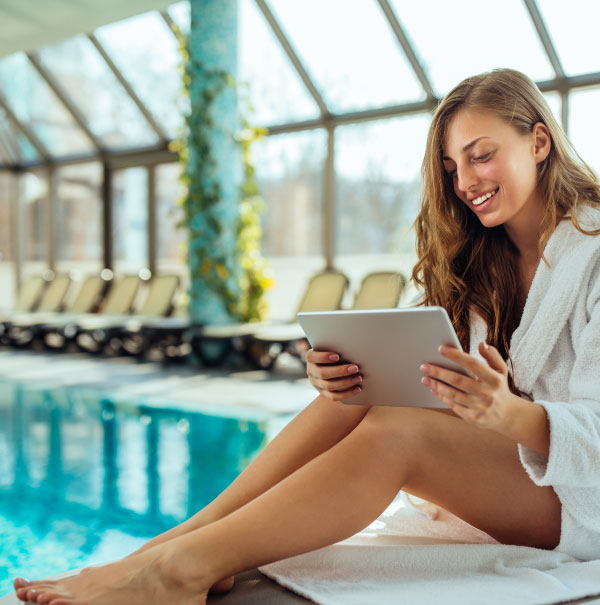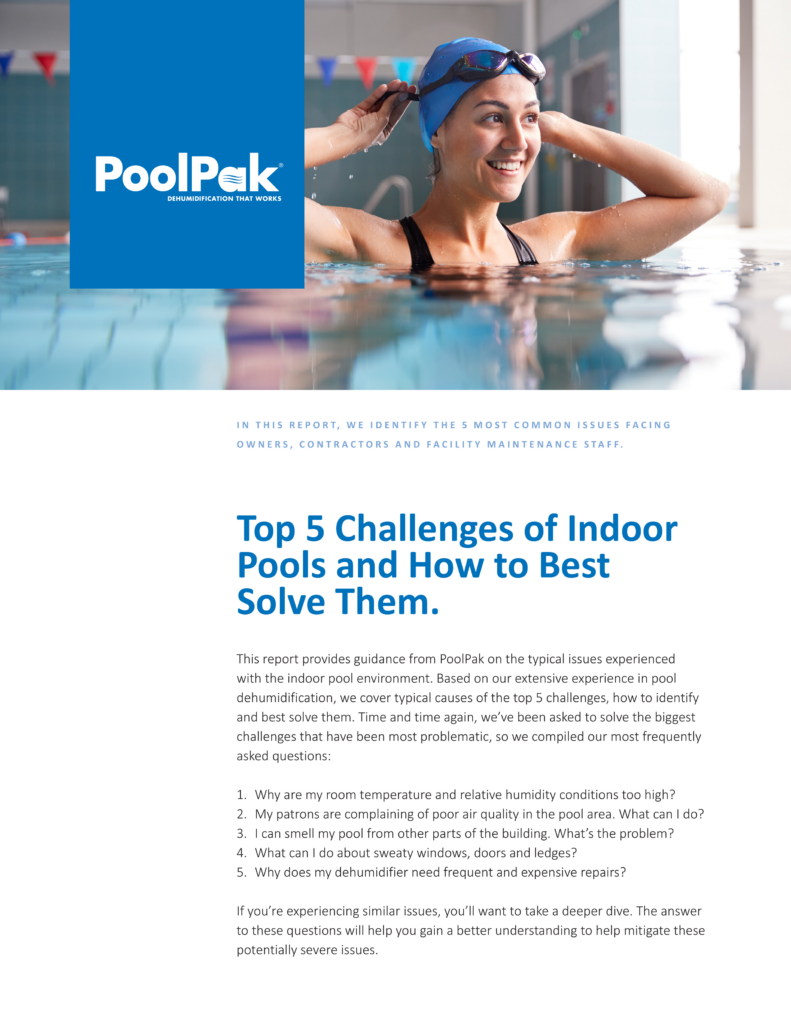
Time and time again, we’ve been asked to solve the biggest challenges with the indoor pool environment. Based on our extensive experience in pool dehumidification, we’ve identified the top five challenges of indoor pools, their typical causes, and how to best solve them.
Here’s challenge number one…
Room Temperature and RH Conditions Are Too High
Indoor pool spaces are meant to be comfortable places for patrons to enjoy recreational swimming. Temperatures are kept warmer than a traditional indoor space for swimmer comfort and energy savings. Additionally, relative humidity (RH) is generally kept between 50% and 60% so that the space humidity is very similar to what it would be like in any other room. When these two measurements (temperature and RH) are where they should be, an indoor pool area is a perfectly enjoyable environment and the facility investment is protected for years to come.
Yet, pools often operate at different setpoints either because of problems with their dehumidification system or because they don’t fully understand the impact of their choices.
Here are some reasons why your indoor pool conditions may not be right:
- Expectations have changed
- Worn down equipment
- Ductwork not operational
- Exhaust fan not functioning
- Outdoor air intake blocked
- More outdoor air than required
Different Operating Parameters
Dehumidifiers are designed and selected for a specific air temperature and RH setpoint, also with a specific water temperature in mind. This is important because these three things will influence the water evaporation rate and that has an impact on whether the dehumidifier is going to be able to keep up with the load and maintain the space. Therefore, the dehumidifier works best when these parameters are not changed. Many recreational pools operate with their water temperatures around 80–85°F and air temperatures between 82° and 85°F. These parameters are popular because they are most likely to keep all users of the pool comfortable, whether they are in the water or on the deck (including lifeguards and other staff).

While 82°F can feel a bit warm when you are fully clothed, some facilities make the mistake of lowering the space temperature. Changing setpoints from the original unit selection criteria will have an impact on system performance and operating costs. If you set the room too cool, you will wind up with increased evaporation and a unit that may no longer properly maintain the space conditions. Conversely increasing the air temperature too much, while rare, would result in an oversized unit that constantly hard cycles its compressor on and off for short periods of time, frequently over-cooling and over-dehumidifying the room. Either are not good operating scenarios and lead to patron discomfort, increased operating costs and greater wear and tear on the equipment.
Lowered Equipment Performance
Unless well-maintained, mechanical equipment will experience diminished performance over time. Indoor pool dehumidifiers are especially vulnerable to this because they operate in a typically corrosive environment and their ideal operating parameters are not always understood by people servicing them. While high-quality machines built today can often last 15 years or longer, older models that are less corrosion-protected tend to last a lot less time.
Equipment Performance Has a Direct Impact on Your Bottom Line
Corroded or improperly operating components, such as cooling coils, heaters and condenser coils, lose their effectiveness over time. It is best to have these components be fully protected with an anticorrosion coating to keep them operating at peak efficiency for the life of the equipment. Older components that have corroded can be replaced, however the pool operator should consider the ROI of replacing old components versus getting new equipment that is equipped with modern features and better corrosion protection.
Additionally, there is much to be gained with regular maintenance of the equipment by people who understand how they should be operating. Internal cleaning, including washing of all coils (inside the unit and also the outdoor heat exchanger coils), can help stave off corrosion. Plus, coils can get dirty over the years and this also lowers their output. For this reason, it is recommended to regularly change return and outdoor air filters, about once per quarter, as they keep small airborne objects from getting caught in the delicate coil fins.
Other Changes
Besides setpoints, other things may have happened at your indoor pool to change the situation.
Here are some other possibilities as to why your indoor pool may be struggling to keep consistent, desirable space conditions:
- Are all supply air and return air openings in your duct work operational? Sometimes they get blocked due to objects in the space, like plants or window treatments. Especially with floor-grade supply air openings, sometimes they are covered up because they were blowing air onto patrons and causing discomfort. But, covering up grilles can limit effectiveness of the dehumidification system.
- The exhaust fan, which may be remote or inside your dehumidifier, could be non-functioning.
- Was the outdoor air intake blocked off to save money? For public spaces, having outdoor air is a code requirement and closing it off completely can significantly deteriorate air quality.
- On the flip side, poor air quality in the space has led some facilities to have more than code required outdoor air blended in. This can cause the dehumidifier to struggle because it must treat additional outdoor air. Keep in mind, more than necessary outdoor air is expensive to treat and does not guarantee better air quality. If your facility is following the code minimum for outdoor air but still struggles with air quality, it may be a good idea to have an expert review your facility because there are likely more cost-effective ways to address the problem than increasing the outdoor air intake.
